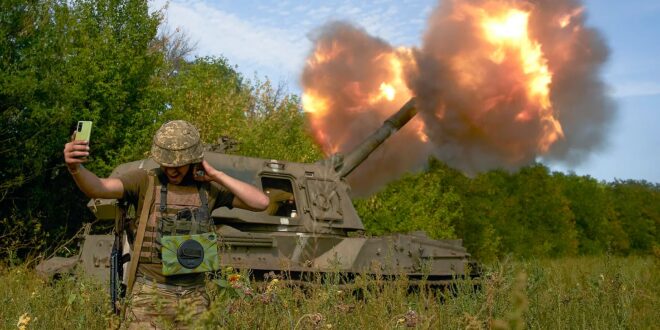In the last 72 hours or so, the pro-Russian side of the internet has been sent into an tailspin of panic over a new Ukrainian counteroffensive which is currently being launched in the Kharkov region, with the intention of compromising the Russian army grouping at Izyum. The panic was triggered by claims that Ukraine was advancing unopposed, encircling – or perhaps even capturing – the city of Balakliya – and on the verge of cutting off supply lines to Izyum.
If you will indulge me, I would like to revive a bit of optimism.
My view is fairly simple: Ukraine cannot and will not reach meaningful objectives – what we call “operational depth” – and has in fact thrown much of its carefully crafted premium reserves into a dangerous position. I believe it’s highly likely that these top rate Ukrainian formations are about to be savaged – but this is still an important learning moment for Russia.
Let’s just get straight into it, starting with an overview of the geography of this area, why Izyum is important, and why Ukraine has very poor prospects of reaching meaningful operational objectives.
Izyum: Gateway to the Donbas
A modest city with a prewar population of perhaps 50,000 people, Izyum was always slated to be a focal point in this war, due to its location at a critical intersection. The topography of northeastern Ukraine is dominated by a few critically important features which determine patterns of movement. These include the crucial E40/M03 highway, which connects the metropolis of Kharkov and the urban agglomeration of Slovyansk and Kramatorsk, which are the largest and most important cities in the western Donbas. The region is furthermore shaped by the Severodonetsk River – alternatively called simply the Donets (from which the Donbas, or Donets Basin, draws its name) – which snakes lazily around the plain.
The Donets forms a geographic barrier between the Donbas to the south and the Kharkov region to the north, while the E40/M03 highway forms the main arterial for transit between Kharkov and the urban centers of the western Donbas. Izyum is a strategically crucial city because it is where the highway crosses the river; as an added cherry on top, the Oskil River – a major tributary of the Donets – confluences with the Donets less than five miles to the east of Izyum, meaning the city essentially sits directly on the intersection of all the most important geographic features of the region. A highly simplified map of the area looks like this:
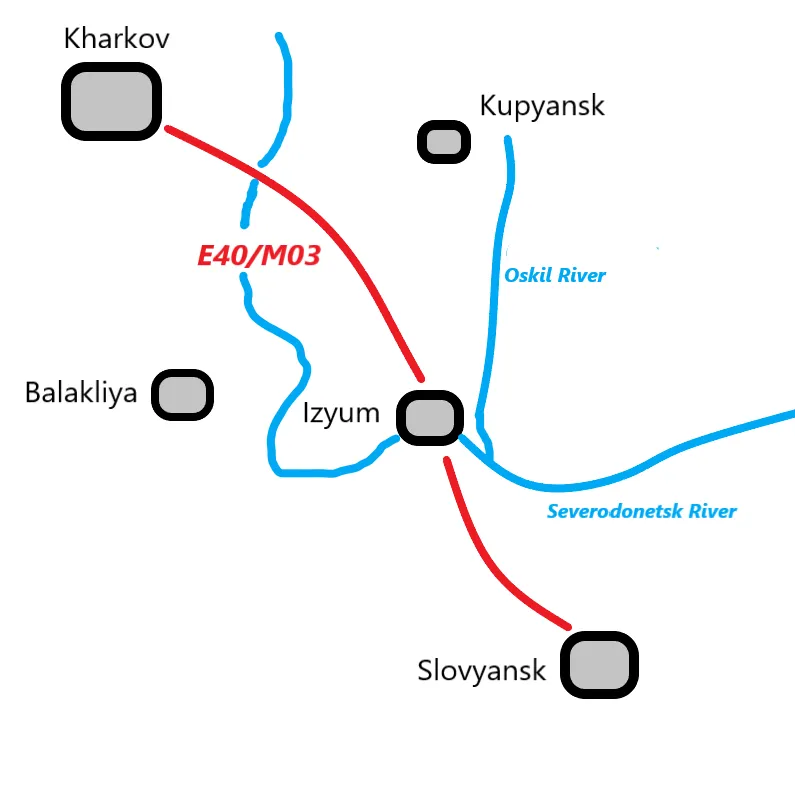
Capturing Izyum was a major objective for Russia in the early weeks of the war (as I argued in a previous piece, this was a major reason for the pinning move on Kiev), because it not only interdicts and complicates supply to Ukrainian forces in the Donbas, but it also gave Russia an early position on the Donets river.
It is obvious why Ukraine would want to dislodge Russia from Izyum. This would simplify and secure lines of communication to Slovyansk and greatly complicate the Russian push in the Donbas by freeing Ukraine’s northern flank. To achieve this, they are attempting a thrust toward Kupyansk, with the aim of cutting the line connecting Izyum to Belgorod in the north. This operation, I believe, is doomed to spectacular failure.
Operational Depth
The panic that set in on the Russian side (on the internet, at least, for there is no evidence that the Russian armed forces panicked) was due to the perception that Ukraine was advancing unopposed towards the east, rapidly approaching Kupyansk and doing… something, to Balakliya. Whether that something is encircling, capturing, or merely screening remains to be determined, as conflicting reports abound at the moment. It is prudent, however, to think about what it means to “advance.” This is a highly contextual question, which depends entirely on the level of resistance being offered and the proximity to operational goals.
Here, we can introduce a notion in military theory that we call “Operational Depth.” Please note, this is not a specific distance – it’s not 20, 50, or 100 km, but it could be any one of those depending on the situation. We’ll define it like this:
Operational Depth refers to the level of advance wherein the attacking force is no longer attacking the enemy’s frontline elements, but is instead directly assailing the enemy’s ability to sustain itself in combat. What this means in practice is that instead of fighting the enemy’s deployed combat units, the attacking force finds itself directly attacking the enemy’s lines of communication, supply depots, command centers, reserves and assembly points, and all the other facets of the rear area. In short, this is the phase where an offensive is exploited. Rather than simply fighting the enemy’s forces, you begin to destroy his ability to sustain and deploy forces altogether.
Now, there are a few major factors which lead to the inevitable conclusion that Ukraine cannot reach operational depth in this counteroffensive – furthermore, in the absence of such a success, they will be savaged and suffer horrific losses. Let’s run through the issues here.
Izyum: The Non-Salient
In military parlance, a “salient” simply means a bulge in the frontline, where one side has achieved some level of penetration at a particular point. A salient is a classically vulnerable position – a glaringly obvious operational focal point, because simultaneous attacks at the base of the bulge can easily cut it off and trap the forces inside. Essentially, a salient is a position where a force is already encircled on 3 sides, leaving only the exit to be snapped shut.
In the opening phase of the war, Izyum was indeed a salient. Russia had captured an exposed position which jutted out into Ukrainian territory, and there was talk of a Ukrainian counteroffensive to take advantage of this. Furthermore, the only safe supply line to Izyum ran through Kupyansk, making this a vulnerable position indeed. Here’s a map from Ukraine War Mapper from early May, for reference:
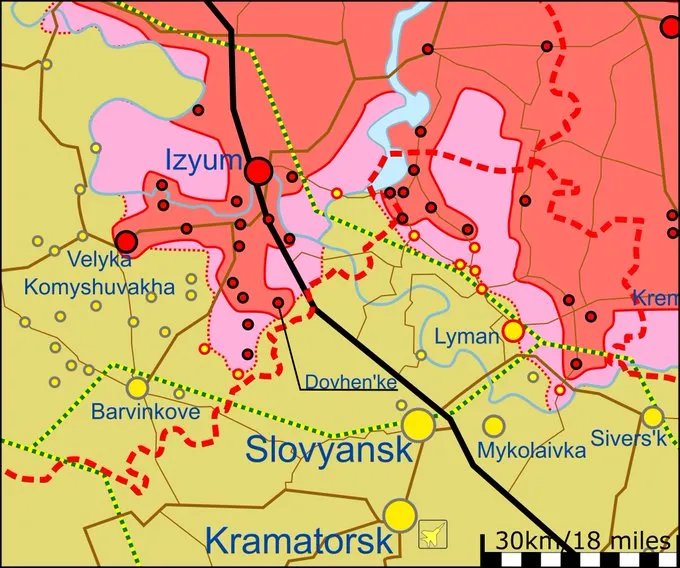
However, throughout the following weeks, Russia took control of the territory directly to the east of Izyum, including the town of Lyman. This concretized the Russian flank and secured additional lines of communication into Izyum, creating redundancies for the highway from Kupyansk. Behold the map in August:
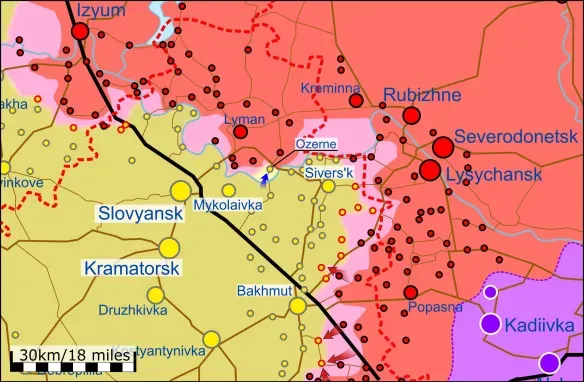
The window of opportunity for an easy encirclement or interdiction of supply to Izyum ended when Russia cleared all the Ukrainian forces from the north side of the Donets river. Supply lines to Izyum are now shielded from the south by the Donets, and from the west by the Oskil.
Because Russia has redundant supply lines to the northeast of Izyum, for Ukraine to reach operational depth, they must cross the Donets and Oskil rivers. Even suppressing Kupyansk is not enough to disrupt Russia’s ability to project force here. The Oskil river – which, incidentally is more than a kilometer wide in places – presents a major barrier that will prevent Ukraine from exploiting their early advances. They have more or less advanced into a wall, and already the map presents an unfolding catastrophe for them. Courtesy of Rybar:
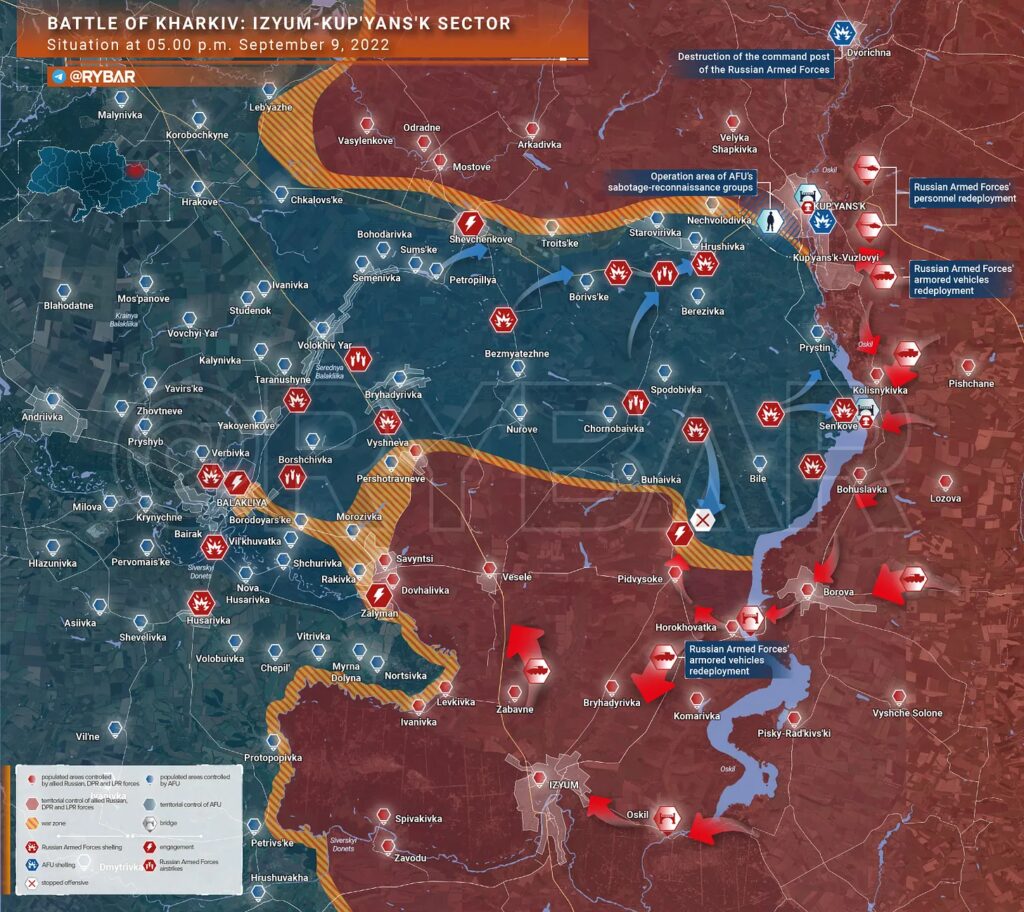
In short, the Ukrainian advance has been too slow and lacks a clear path to reach operational objectives. Already, Russia has begun to deploy huge reserves to this theater, and fear is beginning to show among the more operationally aware Ukrainians. One Ukrainian journalist at the front had this to say:
“There is heavy fighting near Kupyansk, worse than Balakleysky. We are taking heavy losses. The enemy is transferring a bunch of reserves by air. The “Wagnerites” have already arrived in the city itself. The sky is filled with aircraft. Hearing about all this, a haunting feeling of an ambush arises in the soul. What if this all really turns out to be a strategic level ambush?”I do not believe this is an “ambush” per se by the Russian army. The word ambush implies that the Russian forces were already in position, drawing the Ukrainians into a specific maneuver plan where they could be attacked from prepared positions. That’s not what’s happening at all – Russian forces are coming in fresh from reserve and were not pre-deployed to the sector. What the operation reflects instead is Russia’s preference to wage a high-firepower, mobile defense. Frontline positions are, relatively speaking, thinly manned, which powerful mobile reserves are held back. This is a flexible, firefighting approach which allows the Ukrainians to advance into vulnerable positions so that they can be destroyed.
For Ukraine, one of the basic problems is that Russia has such an enormous advantage in firepower – aircraft, tube artillery, rocketry, and tanks – that any offensive must reach operational depth quickly in order to disrupt Russia’s ability to bring this firepower to bear. In the Izyum sector, this simply isn’t possible.
Lacking the ability to operationally compromise Russian forces here, Ukraine will find itself in a good old fashioned shootout against an enemy with vastly superior firepower – not only that, but it is in fact Ukraine that now faces operational complications, having blasted their way into a salient with no prospects for crossing the Oskil in force and exploiting.
What Happens Now?
It seems probable to me that Ukraine’s advance has reached, or is nearing its culmination, as Russian reserves flood into the area, Russia missile strikes attack the Ukrainian command post in Chuguev, and Russian aviation and artillery begin to lay it on thick. The choice Ukraine now faces is whether to continue to funnel forces into the salient that they have created for themselves – in other words, Ukraine now gets to decide the scale of its losses. According to Ukrainian insider channels, they are currently planning to double down and feed more reserves in, promising a correspondingly larger defeat.
I don’t like to make concrete predictions about dates or casualty numbers. There are far too many unknowns for anyone to actually think they can predict such specifics. But regarding the general trajectory, I am confident predicting that Ukraine’s offensive is nearing the high water mark and will soon become a mass casualty event for the Ukrainian army. It may take a few more days for the situation to stabilize entirely, but that point is rapidly approaching and many of Ukraine’s best units face destruction.
However, I would be remiss if I did not make an appropriate critique of Russia’s conduct of this operation. There are still important lessons to be learned.
Future Conduct of the War
While the actual counteroffensive is turning into a catastrophe for Ukraine, the fact that they were able to launch this operation at all has important implications, specifically in regards to Ukrainian manpower.
Russia has been fighting an economy of force operation that aims to destroy the Ukrainian army through attrition. Ukraine’s ability to launch two counteroffensives (Kherson and Kupyansk-Izyum) suggests two important reasons to modify Russia’s force deployment.
1) The Deficiency of Tripwire Defenses
Many sector’s of Russia’s front are thinly manned, with forces being held in reserve to wage a mobile defense. The actual troops at the front amount to a string of token forces who are there primarily to try to slow the enemy while reserves are brought forward. While holding a mobile reserve is the correct approach given the force deployment that Russia has made, this is problematic because it allows the Ukrainians to make temporary gains.
In an operational sense, this isn’t a catastrophe. Russia has the firepower and mobility to crush these offensives. The problem is that it allows Ukraine to temporarily retake settlements, which exposes the civilians in these areas to reprisal killings, such as occurred in Bucha. In the current example, we can look at Balakliya. In and of itself, these city does not have major operational value, but it does have Russian civilians in it who would be exposed to Ukrainian revenge if the city was temporarily recaptured. Russia must reconsider its force deployment so that it can more firmly hold settlements at the frontline for the sake of these civilians.
2) Ukrainian Force Generation
Ukraine’s meta-strategy so far is predicated on a two-tier army. The lower tier consists of poorly trained cannon fodder who man defensive belts and slow down the Russian army with their bodies, by forcing an exchange of artillery shells for their lives. This is the army that Russia is attriting at horrific loss ratios in the Donbas. The first tier Ukrainian army are the forces that are being trained and equipped by western handlers. The Ukrainian scheme is to delay Russia by trading their conscript cannon fodder while they assemble the first tier forces for counteroffensives.
Ukraine has demonstrated that, even if they haven’t competently used these first tier forces, they still have the capability to assemble real strike packages with western help, so long as the lower tier army is able to buy time. This calls into question the Russian strategy of attrition, because it means that Russia is attriting soldiers that Ukraine doesn’t care about. It is probably unwise to allow the west to build yet another army in the rear for yet another wave of counteroffensives.
Russia should evaluate ways to deny Ukraine access to its manpower pool and raise its force deployment to that effect. Nikolayev, Dnepropetrovsk, Zhaparozhia, Odessa, and Kharkov must be taken from Ukraine to that end, and the Russian army must become serious about destroying Ukrainian infrastructure and logistics to prevent Ukraine from continuing the buildup of first tier forces in the rear.
Russia continues to attempt to win the war with a light hand – bare minimum force deployment and precision strikes, sparing critical infrastructure. While the defeat of the current counteroffensives demonstrate that it is still well on the path to victory, the mere existence of these counteroffensives suggests that Russia must raise its force deployment – taking advantage of its significant powers of force generation – and deny Ukraine access to its population pools, or else victory may well be slower and more costly than necessary.
 Eurasia Press & News
Eurasia Press & News
